Cell Towers Near Me - 4G & 5G Locator
Why Finding Your Cell Tower Locations Matters
Cell tower distance matters when it comes to cellular reception. The farther the tower, the weaker your connection. Locating your nearest cell tower helps you:
- Position your cellular devices for a better connection.
- Set up a cell phone signal booster to enhance your cellular signal.
To help make this task easier, we've tested various cell tower locator tools. In this article, you'll find our preferred 7 methods that'll help you find a 4G or 5G cell tower near you.
We fix poor cell phone signal! Find the right signal booster for you:




Or check out our top selling home cell signal booster: weBoost Home MultiRoom
But First, Do Not Rely on Coverage Maps to Find Your 4G or 5G Towers
Contrary to other sources, carrier coverage maps will not help you find nearby cell towers. Their purpose is to show ESTIMATED 5G/4G coverage. Thus, they can only help you identify which carriers offer 4G, LTE, or 5G network reception in your area. If this is your goal, visit our blog on cell phone coverage maps.
However, being in your carrier's coverage bubble does not guarantee reliable reception. Hence spotty cell signal, and why finding your cell tower can be important.
Top 7 Ways to Find Your Nearest 4G or 5G Cell Phone Tower
1) Try a Cell Tower Map Website
Cell tower maps make finding your closest 4G and 5G cell towers easy. By entering your zip code or address, the interactive map will generate cell tower locations near you. While easy and transparent, there’s no way to verify if it's 100% accurate.
Cellular providers don’t publish official cell tower maps. They’re also constantly adding and removing services on cell sites. Thus, the information may be dated.
Not to mention, cellular providers don't like to share towers. So, even if you see one, there's no guarantee it broadcasts your carrier's bandwidths.
Nevertheless, cell tower map sites are a great place to start. When paired with other techniques (mentioned later), you can get as accurate a picture as possible.
#1 Cell Tower Map Website Recommendation
CellMapper is a crowd-sourced cellular tower and coverage mapping service. They take the uploaded information and get details on individual antennas on each cell phone tower.
We’ve found CellMapper to provide the best and most up-to-date cell tower information. It displays 4G, LTE, and 5G cell tower locations from all major cellular providers.
You can locate your closest cellular towers by either zooming in or entering your location. Clicking on the towers reveals estimated broadcasting patterns, max signal strength, frequency band info, address, and more. Unfortunately, CellMapper isn’t very user-friendly.
How to Use CellMapper:
Step 1: Select your Provider
Click the “Menu” widget on the top right corner and then click the “Provider” category. There, click on the “Provider” drop-down box to search for your carrier. You will see lots of provider options from all over the world. To make things easier, type in “310410” for AT&T, “310260” for T-Mobile, or “311480” for Verizon and select your carrier.

Step 2: Select Your Network
Still on the “Provider” category, click on the “Network” drop-down box. Choose either 4G or 5G to view cellular towers from each network. Within seconds, CellMapper will show you 4G or 5G cell tower locations.
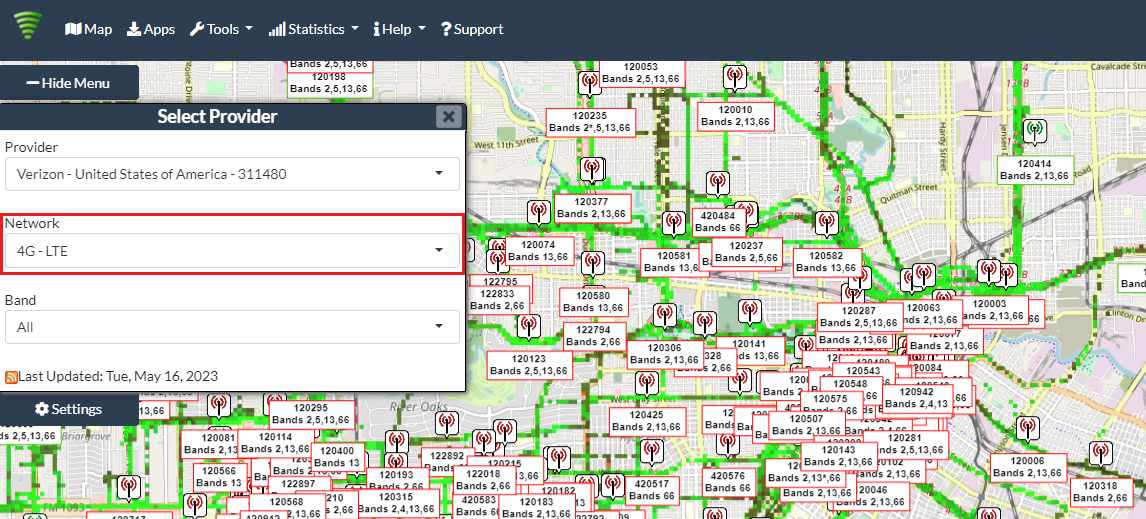
Step 3: Find Your Location
You can pinpoint your desired area by zooming in, which is self-explanatory, or using the “Search” category. You have the option to click “Move to current location” or enter your street name, city name, or zip code.

Step 4: Identify Nearby Cell Phone Towers
You will see green and red cell towers. Green means verified, while red means unverified.
Click on your closest cell towers to identify which ones broadcast in your direction. These will be your best friend. To learn more about the tower, reference the “Tower Info Menu” on the left.
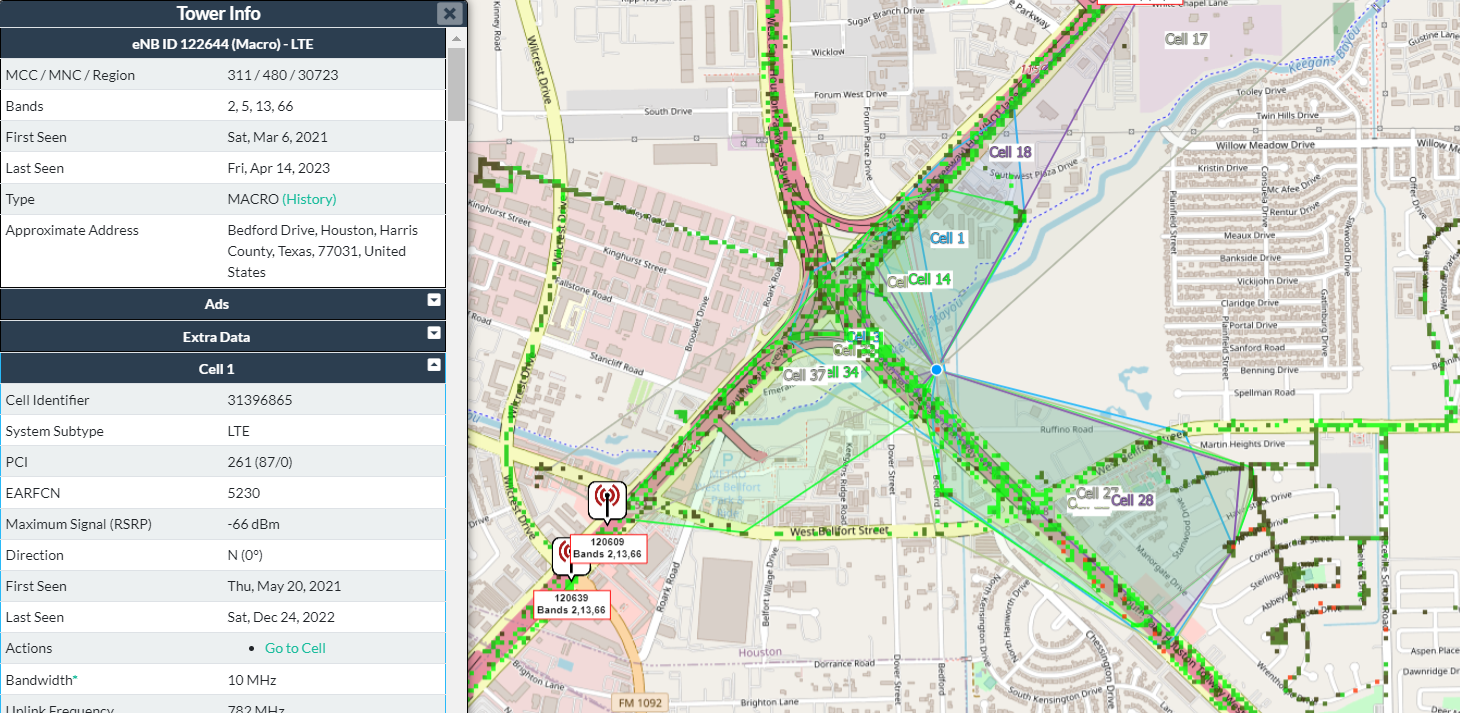
Disclaimer: Cell Mapper does not show signal against geography, nor is it 100% accurate. It provides an approximate ray of signal per frequency. While we still recommend it as a resource, we cannot completely vouch for the information it provides.
The CellReception, Antenna Search, SCADACore, and FCC sites are also good options. Though, the information provided is thin and outdated. In some cases, however, they may provide data that CellMapper doesn’t.
CellReception shows cell tower maps and current user reviews in your area. They display towers registered with the FCC on Google Maps for convenient navigation.
You can search by zip code or city. Once the results are generated, scroll to the bottom of the page to view cell towers in the specified area. Exact cell tower location is provided. Click on the ones closest to you for additional information.
After entering your address, AntennaSearch will display all towers and antennas in its database within a 3-mile radius of your location. The tower and antenna info is listed by carrier or owner.
You’ll need some patience to comb through and click around. The site provides insight on cell tower location, cell tower images, and more. Network information is not available on this site.
Cell tower info found on SCADACore is also sourced from the FCC website. It has over 25,000 locations with corresponding tower and radio information. You can pinpoint your location by entering your coordinates and zooming in. Click on the cell towers closest to you for additional info.
Tower data seems to be much thinner than that available on the websites listed above. It does not provide carrier or network information, so we only recommend this site as a last resort.
2) Download a Cell Tower Locating App
Cell tower locator apps are the most convenient way to find your closest towers. Though, again, it may not be 100% accurate.
Recommended Cell Tower Location and Coverage Quality Apps:
Highly Recommended
For Android
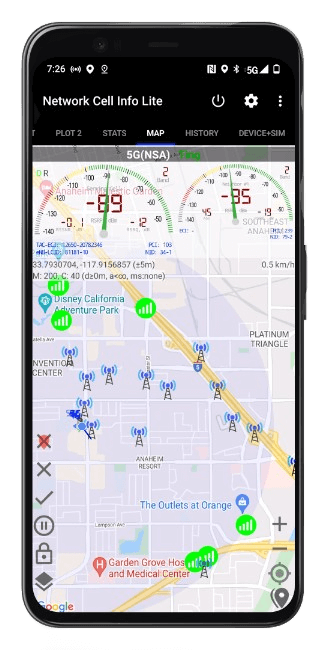
Network Cell Info Lite is our top recommendation. However, it’s only available for Android.
This app not only shows your nearest cell tower, but will show its ID number as well as give you accurate signal strength readings in dB and dBm. dBm can be used as a direct measurement of signal strength, which is far more reliable than the bars on your phone.
Our professional installers use this app more than any other.
Recommended
For Android | For iPhone
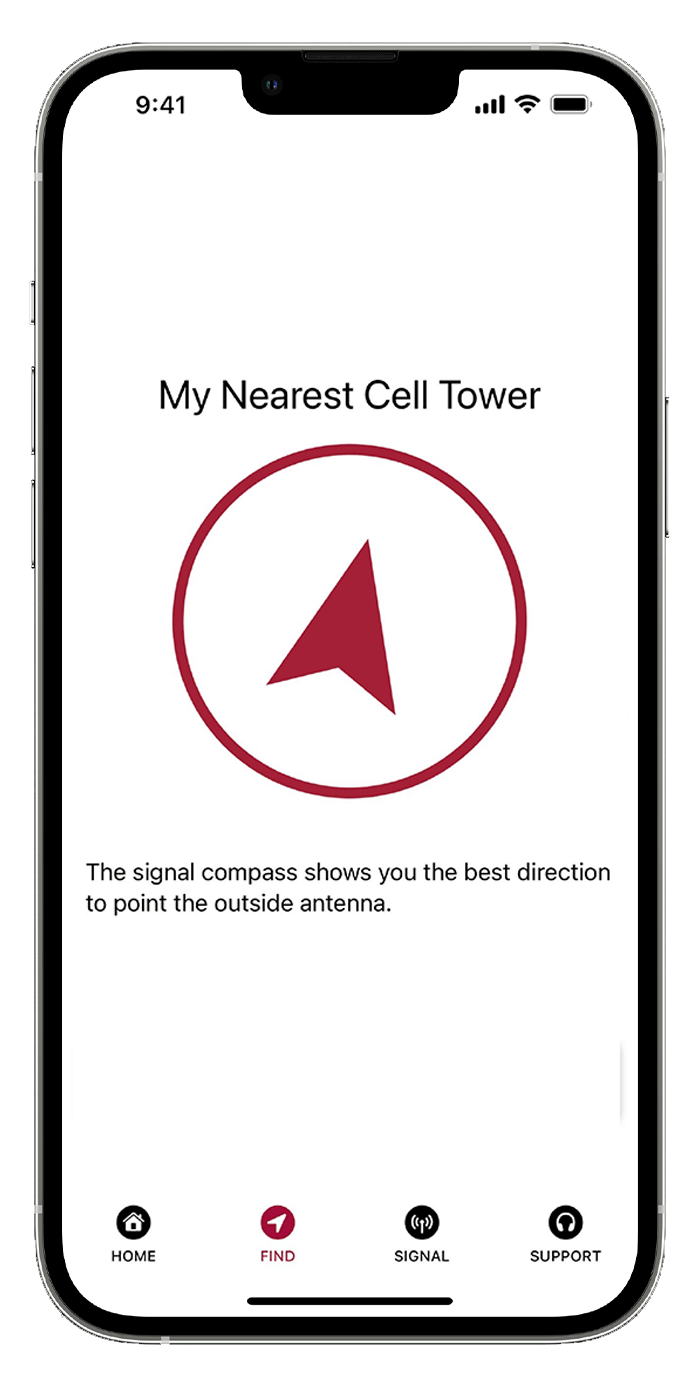
Wilson Electronics developed the user-friendly weBoost app to help with weBoost signal booster installations. One of the features is finding your closest cell tower. It uses your carrier's network and your location to provide accurate results.
To find your nearest tower, tap find on the bottom menu. The cell tower indicator will point in the direction of your closest tower. It doesn't get easier than that.
A weBoost device is not required to use the cell tower finder or signal measurement features.
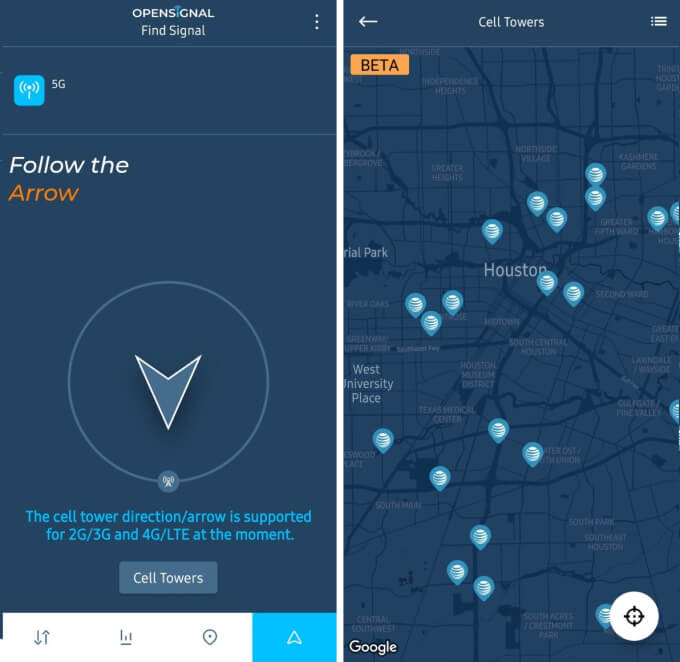
OpenSignal uses crowdsourced and FCC tower location data to provide the best results. It's our third-best cell tower locator app recommendation for Android users. It features an arrow widget that points in the direction of the tower you are connected to and a cell tower map.
During testing, those features did not work on most iPhones. However, it does have up-to-date coverage heatmaps that work on both operating systems. This will help give you a better idea of weak and good coverage areas near you (more so than your carrier's coverage map). You also have the option to test your data speed, wwhich can help iPhone users find the general direction of their closest cell tower.
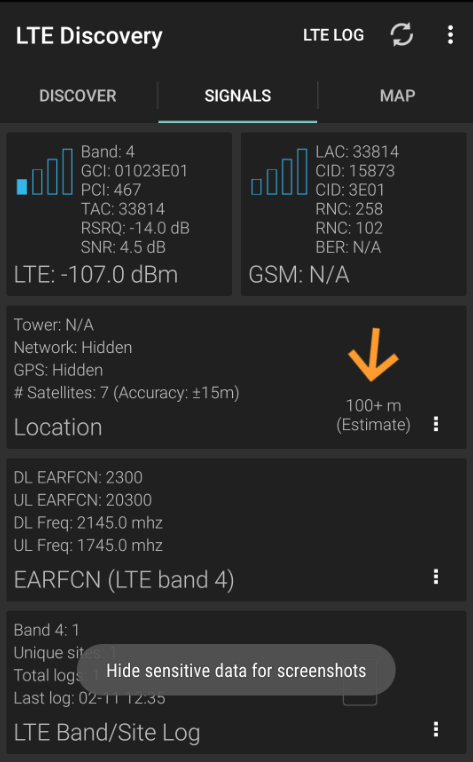
LTE Discovery is powerful, in-depth, and user-friendly enough. While it doesn’t show you exact cell tower locations, the locator tool points in the direction of the tower you're connected to. It also displays dBm readings, frequency band info, and much more.
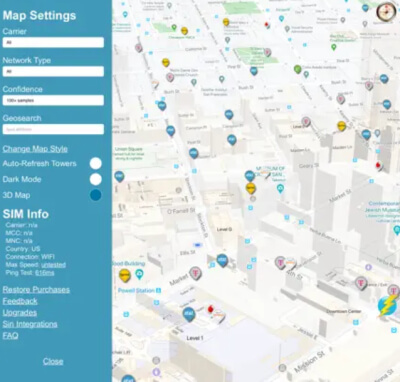
Cellular Network Signal Finder pinpoints and identifies all carrier towers around you. The developer aim to provide up-to-date tower location data and encourages users to report missing towers. You can tap on cell sites near you for additional information, but free data is limited.
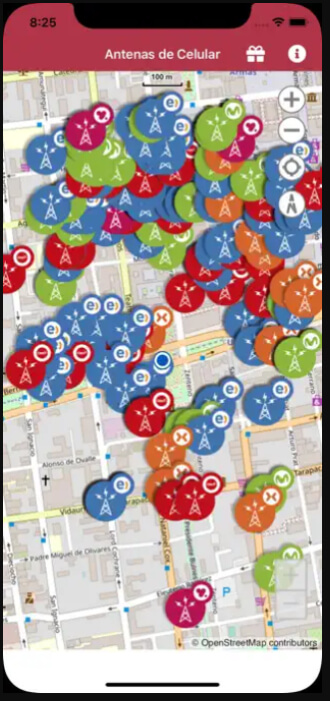
The Cell Antennas app doesn’t have the best ratings, but it’s one of the few iPhone cell tower locator apps that works. It also doesn’t have excessive in-app purchase pop-ups.
Cell tower location data is sourced from the FCC, so it may not be up to date. However, something is better than nothing. When you open the app, it automatically uses your location to display nearby cell towers.
While these apps don’t exactly show you how to boost network signal on Android or iPhone, they help determine the general location of your tower and provide information about the quality of signal strength in your area.
3) Measure Your Signal Strength
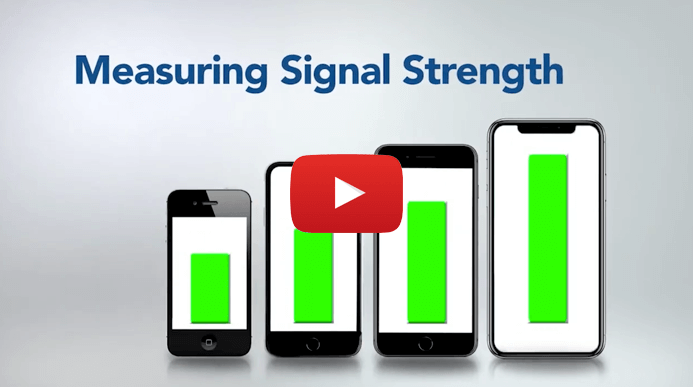
Cell reception increases the closer you are to your tower or the better line of sight you have with the tower. Measuring your cellular signal strength can help you identify where the strongest cell signal is available. That will also show you the general direction of your tower.
Cell phone signals are measured in dBm (decibel-milliwatts). It typically ranges between -50 dBm (considered full strength) to -120 dBm (considered a dead zone). The closer you are to 0 dBm, the better your signal. Most smartphones have the native ability to display dBm readings via Field Test Mode.
How to Access Your dBm Signal (Field Test Mode):
All iPhones can access field text mode, but not all iPhones can view signal strength readings. This will depend on your iPhone chipset (Intel or Qualcomm) and your carrier (Verizon, AT&T, or T-Mobile).
For iOS 16:
- Dial *3001#12345#*
- Tap RsrpRsrqSinr
- Your dBm is read as rsrp.
For iOS 15:
- Dial *3001#12345#*
- Your dBm may be visible on the dashboard’s RSRP section. If not…
- Tap the Menu Tab on the top right corner.
- Tap Cell Info.
- Your dBm is read as rsrp.
Visit How to Read Cell Phone Signal Strength for Field Test Mode instructions on older iPhone Operating Systems.
If unable to find your signal strength, you most likely have an incompatible carrier and chipset. The next best method is performing a speed test inside and outside your home. You can use the OpenSignal app for this.
Once we crack the code on iPhone dBm readings, we’ll update you as soon as possible. In the meantime, you can ask Apple to make dBm info easily available for all iPhones. Maybe if enough people reach out, their next software update will include an improved field test mode.
Field test mode on Android varies by phone model and Android OS version. However, it's generally found under the Settings menu.
Typical sequence:
- Tap Settings
- Tap About Phone
- Tap Status or Network
- Tap SIM Status
- Your dBm is under Signal Strength
If this did not work for you, visit How to Read Cell Phone Signal Strength for alternative sequences.
Once you have field test mode or your speed tester ready, walk around inside and outside the perimeter of your home. Make note of which areas get the best dBm reading or the fastest speeds. This shows you the general direction of your cell tower and which rooms inside your home have the best reception.
4) Check Cell Tower Company Websites
Cell tower companies keep records of the cell towers they own and manage. You can find these maps on their website. SBA Communications, Crown Castle, and American Tower are the top three cell tower companies in the US.
SBA Communications and Crown Castle cell tower maps are pretty easy to navigate. Both allow you to zoom in or search by address. SBA offers additional search options. You can also search by site ID/name or coordinates.
American Tower requires you to have an account to view their cellular tower map.
While a helpful resource, they do not disclose which cellular providers operate on said cell towers.
5) Try Wardriving
Wardriving is the act of searching for wireless networks while moving in a motorized vehicle. In this case, you’d be searching for the physical location of your closest cell tower.
You’ll need a signal strength reader and a tower identifier (PCI or eNodeB ID). The tower identifier is typically available in certain signal strength apps like Network Cell Info Lite and on some iPhones via Field Test Mode.
Using the signal strength app, walk around your home to identify the cell tower that delivers the strongest signal. If the tower identifier consonantly changes, that means there are multiple towers nearby. Once you have the PCI or eNodeB ID you want to hunt for, start wardriving towards the tower. Eventually, you’ll see it.
Wardriving allows you to see exactly how far the cell site is from your home as well as all the obstacles in the way. If you’re lucky enough to have multiple towers close by, you’ll be able to easily identify which one is best to point your signal booster antenna towards.
6) Update Your Phone to New Cell Towers
Usually, your phone is connected to the nearest cell tower. However, it’s possible your provider has installed a new tower in your area, added an antenna to a nearby tower, or recently configured their towers. Performing a tower update is simple, but it varies for each carrier and device.
For iPhone
There are three basic ways to update the latest AT&T cell tower on your iPhone:
Turn Network Off and Back On
Tap the "Airplane" icon to turn it on and then tap it again to turn it off to reconnect to the network. This is far and away the simplest method.
Download Carrier Update
- Go to your Settings
- Tap General
- Tap About
- If a carrier update is available, tap Install
Restart iPhone
Should these fail, try the standard off and on again strategy.
For Android
There are three basic ways to update the latest AT&T cell towers on your Android device:
Turn Network Off and Back On
Swipe down from the top of the screen to show your Android's Quick Settings menu. Tap the “Airplane” button to turn it on, wait 10 seconds, and then turn it off. Your Android phone will reconnect to the strongest AT&T connection available. This is the fastest, and simplest method.
Update Android Software
- Tap Settings
- Tap About Device
- Tap Software Update
- Wait for your Android phone to search for an update
- Tap Install Now
Restart Android Device
Should these fail, try the standard off and on again strategy. It usually works.
Updating to the latest Verizon cell towers is easy and can be done in several ways.
Restarting your device usually causes the location memory of your phone to reset. This forces the device to connect to the nearest Verizon towers.
Alternatively, you can dial “*288” and select “2” when prompted. This will cause your phone to update to local Verizon towers. The process can take up to two minutes.
The final method is dialing “*22899” and press “Send.” A musical ringtone will play, and a recorded voice will instruct you to hold while your phone is programmed. A few seconds later, you should hear a few beeps, and “Programming Successful” will appear on your display. Your Verizon cell towers are now updated.
To update your T-Mobile towers, you can try the AT&T methods above, or this alternative restart method:
- Power off your device
- Remove your SIM card
- Wait a minute or so
- Insert SIM card and power your phone back on
- Your phone should automatically perform a T-Mobile tower update.
The best way for US Cellular customers to update their cell tower is using therestart method. Either:
- Toggle airplane mode on and off (described above), or
- Power your device off, remove the SIM card, wait a minute, reinsert SIM, and power the device back on.
7) Use a Signal Meter (Best Result)
Using field test mode, apps, and websites is generally a good way to locate your closest tower. However, if you're an installer, contractor, or pro who really wants to be accurate, then getting a signal meter is a no-brainer.
It's a handheld device that:
- Tracks 4G & 5G signals
- Identifies individual carriers and towers
- Displays signal strength in dBm
- Offers details on location, tower ID, distance to tower, and more
Signal meters are a worthwhile investment for professionals in telecom or those who want a bulletproof setup.

Professional-grade handheld 5G/4G signal meter.
Buy Now for : $1,299.99A 4G only signal meter is also available.
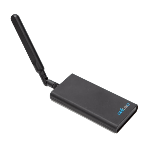
Professional-grade handheld 4G LTE network signal meter.
Buy Now for $599.99How to Find 5G Towers Near Me?
Most of our tips work best for finding 4G cell towers. Pinpointing 5G tower locations is a bit more complicated.
As of right now, the best resource available to find your closest 5G cell tower is cellmapper.com. Simply choose your carrier, select 5G, and enter your address.
We found that T-Mobile's 5G tower map has the most data. AT&T 5G cell tower and Verizon 5G cell tower info is very thin. You’ll mostly see different shades of green and red squares. They represent the strength of the signal devices in that area received from nearby towers.
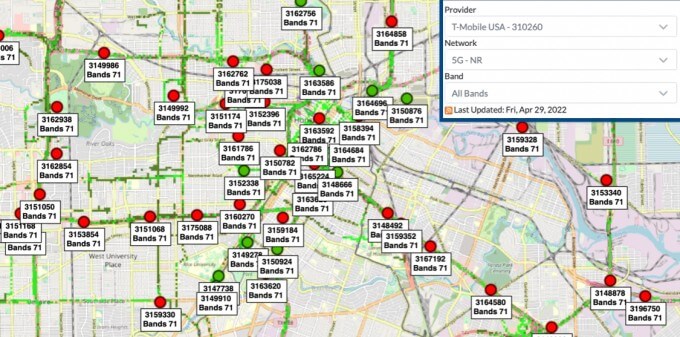
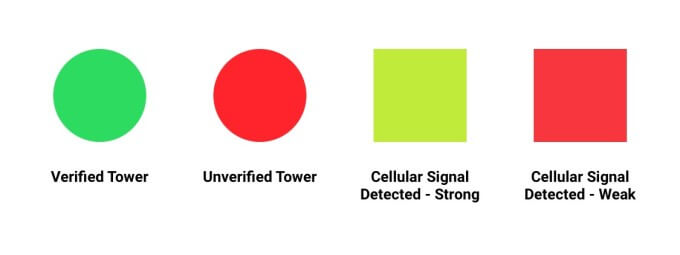
While 5G cell towers may not be labeled on the map, there might still be 5G cell towers nearby. You can use your phone to find their general direction.
Before you start, though, make sure you’re in a 5G area. If you have a 5G phone and 5G is enabled, the 5G icon on the status bar is usually a tell-tale sign that it is. Wherever the signal is strongest shows you the general direction of the tower.
If the icon isn’t visible or you don’t have a 5G device, your carrier’s 5G coverage map, Ooklas 5G map, and OpenSignal’s coverage maps are great resources. Though, they won’t display the exact tower location.
Knowing where your closest 5G tower is located can help you get better 5G signal, but it’s not a crucial step for most signal booster installations. Most signal boosters only boost 4G/LTE and low-band 5G, which performs very similarly to 4G/LTE. You don’t have to stress about finding your closest 5G tower.
What About 3G Towers?
AT&T, Verizon, and T-Mobile's have shut down their 3G network. Infrastructure is being used to build newer networks.
FAQs
Why Aren’t There Accurate Maps of Tower Locations?
Cellular providers are not required to publicly disclose their 4G and 5G cell tower locations. Most carriers prefer to keep that information on the down low due to safety and security reasons.
Most cell tower data is acquired through the FCC database and crowdsourcing. The FCC only requires AT&T, Verizon, T-Mobile, and other carriers to register cell towers over 200 feet. There are tons of cell sites that aren't that tall, such as small cells, which are very important for 5G deployment. Also, crowdsourced data isn't always correct.
Thus, cell tower locator maps aren't 100% accurate.
How Do Cell Towers Work?
Cell towers, also known as cell sites or base transceiver stations, are designed to send and receive radio frequency signals. They typically consist of multiple antennas that broadcast 4G, LTE, and 5G frequencies in a specific direction. These frequencies vary across carriers.
Your cellular-enabled devices pick up your carrier’s frequencies allowing you to make calls, send texts, and browse the web. If the cell tower does not contain antennas that broadcast your carrier’s frequencies, or those antennas face away from you, your connection will be wonky even if you live right next to an obvious cell tower.
To learn more about frequency bands, visit “Cellular Frequency Bands by Provider” or “5G Frequency Band Explained”.
How Far Can Cell Towers Reach?
Cell tower reach is a tricky thing. There are many variables that impact cell tower range, such as:
- Cellular frequency
- Antenna height
- Transmission power
- Weather conditions
- Obstructions
The number one contributor, though, is cellular frequency wavelengths. Lower frequencies have longer wavelengths, so they can travel farther distances. Higher frequencies have shorter wavelengths, allowing faster speeds and greater capacity at the cost of a shorter range.
In general, though, 4G cellular towers have a range of about 10 miles. Of course, distance will vary from low to high 4G frequency bands. When it comes to 5G cell towers, distance is significantly different across 5G bands.
| 5G Frequency Band | Deployment | Cell Tower Distance |
|
5G Low-Band 600 MHz-1 GHz |
Nationwide | Similar reach as 4G towers with slightly faster speeds |
|
5G Mid-Band (Includes C-Band) 1-6 GHz |
Metro Areas | Between .5 to 6 miles |
|
5G High-Band (aka Millimeter-Wave) 24-47 GHz |
Dense Urban | Up to 1,500 sq ft |
Need to Get the Best Signal from Your Closest Cell Tower? A Signal Booster Can Help!
If you're suffering from dropped calls, unsent emails, excruciatingly slow data, and poor signal, you basically have two options: depend on a landline WiFi connection or BOOST your cellular signal.
Cell phone boosters are powerful devices that communicate with your nearest cell tower, pull in the signal, amplify it, and then rebroadcast the boosted signal wherever you need it. There are boosters for home, offices, and vehicles.
Now that you know how to find your closest cell tower, installation is going to be much easier.
If you have any questions, give us a call at 1-800-568-2723.
We fix poor cell phone signal! Find the right signal booster for you:




Interested in Learning More? Check Out Our Signal Boosting Info Center


Money Back Guarantee

Technical Support